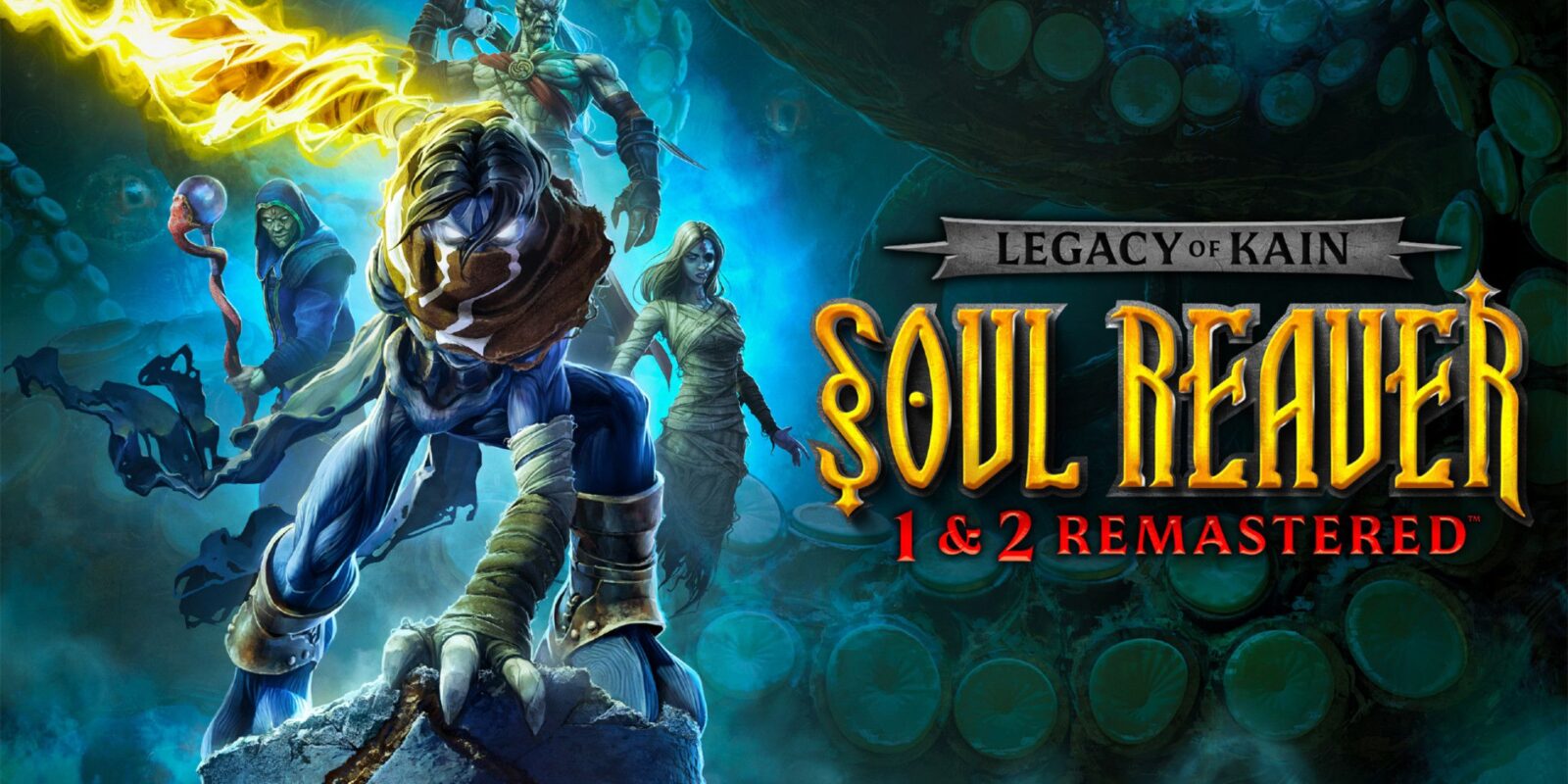If you’re a fan of the originals and just looking to hear if Legacy of Kain: Soul Reaver 1 & 2 Remastered is worth its $30 asking price, then here’s the short answer: it is. But if you’re new to the series or hoping for a full-fledged modern trip back to Nosgoth, you may want to know a few more details, as Legacy of Kain: Soul Reaver 1 & 2 Remastered, while terrific in many ways, might not exactly rock your world.
Taking place centuries after the events of Blood Omen: Legacy of Kain, the Soul Reaver duology follows one of the titular Kain’s quasi-sons, Raziel, as he embarks on a journey of revenge, redemption, and revelation. The world of Soul Reaver is a dark and dour one, characterized by a vampiric presence that, while once a rapidly encroaching scourge, now dictates society’s modus operandi, pushing humanity near the brink of extinction. Raziel himself is a grotesque and inhuman beast, and there’s no hope for him beyond fulfilling an eldritch prophecy that requires him to leave a trail of corpses in his wake.
Needless to say, it’s a narrative of epic of Shakespearean proportions, and it’s delivered beautifully through environmental storytelling and some of the best voice acting the industry has ever seen. The Soul Reaver games, despite their vaguely nu-metal visual tendencies and late-90s edginess, are mature and sophisticated, presenting high-concept ideas to the player in a way that is compelling, nuanced, and still remarkably original all these years later. Indeed, the story and worldbuilding of Soul Reaver hold up beautifully. I only wish I could say the same about the gameplay.
Soul Reaver: A Short Retrospective
As a vampire, Soul Reaver protagonist Raziel is capable of continual growth and evolution, which culminates in him sprouting wings at the start of the game. The growth of his wings positioned him as, in some ways, superior to Kain—something that cannot stand in his inner vampiric circle. Such treachery is duly punished, as Kain breaks Raziel’s wings and throws him into the Lake of the Dead, an act that results in him transforming into something of a walking corpse, seeking revenge for his grim fate.
Soul Reaver‘s story is not without Biblical undertones, which are reflected in its level design and other minute details. Soul Reaver clearly draws upon Abrahamic religions on both the micro and macro levels, as the environments of the game are replete with the stained-glass artwork, frescoes, and stonework that one would expect to find in a stereotypically Gothic cathedral or temple. It’s a joy to explore these areas, even if they are somewhat rudimentary by modern standards.
What players do in these areas is, admittedly, often less interesting. At the risk of being reductive, the first Soul Reaver is a “Zelda-like,” in the sense that its structure is defined by a series of self-contained dungeons that leverage Metroidvania design principles to control player progression. The majority of Soul Reaver‘s gameplay consists of solving puzzles, which can be hit or miss. Sometimes, they are wickedly clever and satisfying, but they can also border on mind-numbing or frustrating. They typically revolve around using Raziel’s Spectral Realm Shift ability, finding the correct environmental elements to interact with, and moving blocks to the correct spots. Your tolerance for that last puzzle type will likely determine how much you enjoy Soul Reaver‘s moment-to-moment gameplay.
Combat assumes a similarly puzzle-like formula. Raziel has fairly basic combat abilities, but with most of the enemy NPCs being undead, they must be killed by impaling or throwing them into spikes, water, fire, or sunlight. It’s surprisingly satisfying to survey the environment, identify the proper hazards or short-term weaponry, and use them to dispatch enemies, which makes up for the fact that the actual melee mechanics are painfully outdated. Combat does lose this puzzle-like quality as the game progresses, however, as Raziel’s newfound powers make enemy encounters considerably easier—perhaps too easy.
Soul Reaver 2 Completes the Package
Without getting into spoilers, Soul Reaver 2 picks up where its predecessor left off, both in terms of gameplay and narrative. The story of the second game is an improvement over the first, at least in terms of presentation, as better and more abundant cutscenes, alongside an improved soundtrack and more varied environment design, help make for a compelling, cinematic, well-paced experience.
Gameplay is more of the same, though with some new bells and whistles. For one thing, while Soul Reaver is open-ended, with a lot of backtracking and little in the way of hand-holding, Soul Reaver 2 is surprisingly linear, assuming the features of a conventional action-adventure game. This fits the more consistent pacing of its narrative, especially as the stakes are raised and the lore grows more complex. But some may find the linearity to be a step backward from the ahead-of-its-time open world of the first game. Aside from this broad structural change, combat is slightly enhanced, with a new block ability and more weapons to choose from, and puzzles are more varied (there are far fewer block puzzles this time around).
It should be noted that Soul Reaver ends on a tantalizing cliffhanger, so Soul Reaver 2 is basically essential for those looking to get the full story. The pair of games can be likened to the most recent God of War titles, in that they are more like two chapters of a broader narrative than two separate stories.
Legacy of Kain Soul Reaver 1 & 2 Remaster Is Serviceable, But Not Mind-Blowing
Everything mentioned up til this point applies to the original releases of the Soul Reaver games just as much as to these remasters, as Aspyr has ostensibly not touched any aspects of the classic versions aside from updating the graphics, adding stability, and introducing a few quality of life features. Gameplay, level design, and (thankfully) voice acting and writing are all unchanged.
Perhaps the greatest thing that Aspyr has accomplished with these remasters is making the Soul Reaver games available on modern hardware. Current-gen consoles can finally run these games, but PC players also now have an alternative to the original releases, which have long been buggy, unstable, and riddled with miscellaneous performance issues. I’m pleased to report that neither Soul Reaver game in the remastered bundle gave me any issues on PC.
Unlike the Spyro Reignited Trilogy, which dramatically modernized the visuals of the original PS1 releases to the point where they became indistinguishable from modern games, Legacy of Kain: Soul Reaver 1 & 2 Remastered is more akin to an HD texture pack for an older game. The geometry of these titles is still noticeably polygonal, animation runs the gamut from stiff to goofy and weightless, and modern details like simulated reflections and particle effects are nowhere to be found. To put it plainly, these remasters look more like PlayStation 2 games rendered at 1080p than something built for current-gen consoles.
That may sound derisive, but it’s a bit more complicated than that. Spyro Reignited Trilogy is an impressive modernization of a classic franchise, but by sanding down all of its rough edges, something of the original’s spirit is lost. Soul Reaver 1 & 2 Remastered, on the other hand, retains much of the same visual style of its progenitors; it is faithful to their visuals despite the obvious differences. In other words, it doesn’t transform the series’ aesthetic, but merely spruces it up a bit.
You can switch between the new and old
Soul Reaver
graphics at any time with the press of a button, which is a nice touch for those who want the originals’ visuals with the benefits of the remake’s better performance.
With all that in mind, it’s tricky to objectively assess the value proposition of this game. Legacy of Kain: Soul Reaver 1 & 2 Remastered offers, in many ways, the same things that the original Soul Reavers did: a compelling, grand narrative, a unique world to dissect, incredible atmosphere, et cetera. For that alone, this remaster is worth purchasing, as it is essentially the “definitive” version to play these games.
At the same time, nothing substantial has been brought to the table through this re-release other than the graphics which, for the aforementioned reasons, aren’t anything to write home about. If you bounced off the originals, or if you have reliable access to them and don’t mind their dated graphics, then Soul Reaver 1 & 2 Remastered might not be worth the cost of admission. But if you’ve never delved into the world of Nosgoth, are looking for a great story, and don’t mind putting up with some archaic mechanics, it’s an easy buy.

Reviewed on PC
- Released
- December 10, 2024
- One-of-a-kind narrative
- Terrific voice acting
- Unique game mechanics
- Not a huge improvement over the originals
- Dated gameplay
Legacy of Kain: Soul Reaver 1 & 2 Remastered releases on December 10, 2024 for PC, Xbox One, Xbox Series X|S, PlayStation 4, PlayStation 5, and Nintendo Switch. Game Rant was provided a PC code for this review.











Leave a Reply